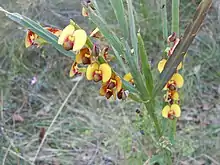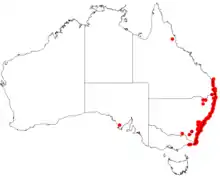Bossiaea ensata
Bossiaea ensata, commonly known as sword bossiaea,[2] is a species of flowering plant in the family Fabaceae and is endemic to south-eastern continental Australia. It is an erect or low-lying, glabrous shrub with flattened branches, flattened, winged cladodes, leaves mostly reduced to small scales, and orange-yellow and red flowers.
| Sword bossiaea | |
|---|---|
 | |
| Bossiaea ensata at Cowan | |
| Scientific classification | |
| Kingdom: | Plantae |
| Clade: | Tracheophytes |
| Clade: | Angiosperms |
| Clade: | Eudicots |
| Clade: | Rosids |
| Order: | Fabales |
| Family: | Fabaceae |
| Subfamily: | Faboideae |
| Genus: | Bossiaea |
| Species: | B. ensata |
| Binomial name | |
| Bossiaea ensata | |
 | |
| Occurrence data from AVH | |
Description
Bossiaea ensata is an erect to low-lying or sprawling, glabrous shrub that typically grows to a height of 1–2 m (3 ft 3 in – 6 ft 7 in) and has flattened branches and flattened, winged cladodes 2–10 mm (0.079–0.394 in) wide. The leaves, when present, are reduced to triangular scales 0.6–2 mm (0.024–0.079 in) long. The flowers are 6–10 mm (0.24–0.39 in) long and arranged singly in leaf axils 6–10 mm (0.24–0.39 in) long on pedicels up to 4 mm (0.16 in) long with two bracts up to 2 mm (0.079 in) long at the base and bracteoles near the middle of the pedicels. The sepals are 3–4 mm (0.12–0.16 in) long and joined at the base forming a bell-shaped tube, the two upper lobes longer than the lower three lobes. The standard petal is yellow with a red base and with red streaks or blotches on the back. The wings are yellow, sometimes with a red tinge and the keel pale greenish yellow. Flowering occurs from September to October and the fruit is an oblong pod 25–40 mm (0.98–1.57 in) long.[2][3][4][5][6]
Taxonomy
Bossiaea ensata was first formally described in 1825 by Augustin Pyramus de Candolle in Prodromus Systematis Naturalis Regni Vegetabilis from an unpublished description by Franz Sieber.[7][8] The specific epithet (ensata) means "sword-shaped", referring to the flattened stems.[9][10][11]
Distribution and habitat
Sword bossiaea usually grows in sandy heath and is found on the coast and nearby tablelands of south-east Queensland, New South Wales and Victoria as far west as Marlo. There is also a record from the south of South Australia.[2][3][4]
References
- Burnett, Mary A. (1842). Plantae utiliores. London: Whittaker & Co. p. 530. Retrieved 23 July 2021.
- Ross, James H. "Bossiaea ensata". Royal Botanic Gardens Victoria. Retrieved 23 July 2021.
- "Bossiaea ensata". Royal Botanic Garden Sydney. Retrieved 23 July 2021.
- "Bossiaea ensata". State Herbarium of South Australia. Retrieved 23 July 2021.
- Wood, Betty. "Bossiaea ensata". Lucid Keys. Retrieved 23 July 2021.
- Wild Plants of Victoria (database). Viridans Biological Databases & Department of Sustainability and Environment. 2009.
- "Bossiaea ensata". APNI. Retrieved 23 July 2021.
- de Candolle, Augustin P. (1825). Prodromus Systematis Naturalis Regni Vegetabilis. Vol. 2. Paris. p. 117. Retrieved 23 July 2021.
- Sharr, Francis Aubi; George, Alex (2019). Western Australian Plant Names and Their Meanings (3rd ed.). Kardinya, WA: Four Gables Press. p. 191. ISBN 9780958034180.
- "Bossiaea ensata". Australian Native Plants Society (Australia). Retrieved 23 July 2021.
- William T. Stearn (1992). Botanical Latin. History, grammar, syntax, terminology and vocabulary (4th ed.). Portland, Oregon: Timber Press. p. 406.
.jpg.webp)